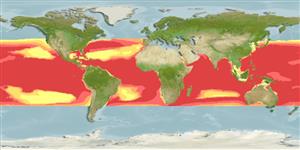Teleostei (teleosts) >
Myctophiformes (Lanternfishes) >
Myctophidae (Lanternfishes) > Lampanyctinae
Etymology: Lampadena: Greek, lampas, -ados = torch + Greek, aden = gland (Ref. 45335).
More on author: Garman.
Environment: milieu / climate zone / depth range / distribution range
Ecology
Marine; bathypelagic; oceanodromous (Ref. 51243); depth range 50 - 1021 m (Ref. 27311). Deep-water; 44°N - 37°S
Atlantic, Indian and Pacific: between 20°N and 20°S but extensions into higher latitudes in western boundary currents (Gulf Stream to 43°N; Brazil to 36°S; Agulhas to 39°S; Kuroshio to 34°N). Abundant in the Tungsha Islands in South China Sea (Ref. 39633). All the china sea regions (Ref.74511).
Length at first maturity / Size / Weight / Age
Maturity: Lm ?, range 15 - ? cm
Max length : 20.0 cm SL male/unsexed; (Ref. 4479)
Oceanic and mesopelagic. Found between 425-850 m during the day and in the upper 100 m at night. Small specimens found in the upper 50 m (night).
Life cycle and mating behavior
Maturities | Reproduction | Spawnings | Egg(s) | Fecundities | Larvae
Hulley, P.A., 1990. Myctophidae. p. 398-467. In J.C. Quero, J.C. Hureau, C. Karrer, A. Post and L. Saldanha (eds.) Check-list of the fishes of the eastern tropical Atlantic (CLOFETA). JNICT, Lisbon; SEI; Paris; and UNESCO, Paris. Vol. 1. (Ref. 4479)
IUCN Red List Status (Ref. 130435)
Threat to humans
Harmless
Human uses
Tools
Special reports
Download XML
Internet sources
Estimates based on models
Preferred temperature (Ref.
123201): 8.3 - 19.2, mean 12.7 °C (based on 990 cells).
Phylogenetic diversity index (Ref.
82804): PD
50 = 0.5010 [Uniqueness, from 0.5 = low to 2.0 = high].
Bayesian length-weight: a=0.00501 (0.00233 - 0.01079), b=3.15 (2.97 - 3.33), in cm total length, based on LWR estimates for this (Sub)family-body shape (Ref.
93245).
Trophic level (Ref.
69278): 3.2 ±0.2 se; based on size and trophs of closest relatives
Resilience (Ref.
120179): Medium, minimum population doubling time 1.4 - 4.4 years (Preliminary K or Fecundity.).
Fishing Vulnerability (Ref.
59153): Low vulnerability (14 of 100).
